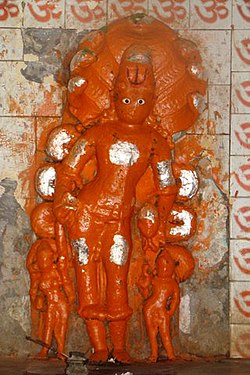Takshaka
This article needs additional citations for verification. (February 2024) |
| Takshaka | |
|---|---|
 Idol of Takshaka at Taxakeshwar temple | |
| Devanagari | तक्षक |
| Sanskrit transliteration | Takṣaka |
| Affiliation | Nāga |
| Abode | Indrapuri |
Takshaka (
Takshaka are also known in Chinese and Japanese mythology as being one of the "eight Great Dragon Kings" (八大龍王 Hachi-dai Ryuu-ou),[1] they are the only snakes which can fly and also mentioned as the most venomous snakes, amongst Nanda (Nagaraja), Upananda, Sagara (Shakara), Vasuki, Balavan, Anavatapta and Utpala.
Hinduism
The King of the Nagas
Takshaka is mentioned as a King of the Nagas at (1,3).
Takshaka is mentioned as the friend of Indra, the king of gods, at (1-225,227,230). Takshaka, formerly dwelt in
Legend
According to the
Takshaka lived in the Khandava forest (1,225). Nagas lived there with other tribes like the
Revenge on Pandavas

Later King
Utanka soon became another victim while he was passing through the domain of Takshaka. By visiting Janamejaya, Utanka invoked the ire of that
. Janamejaya had to listen to the words of the learned Astika and set Takshaka free. He also stopped the massacre of the Nagas and ended all the enmity with them (1,56). From then on, the Nagas and Kurus lived in peace. Janamejaya became a peace-loving king as well.Other references
Takshaka, disguised as a beggar, stole the earrings of
In the chapters (14-53 to 58) Uttanka's history is repeated where the ear-rings were mentioned to be of queen Madayanti, the wife of king
- A king named Riksha in the race of Lunar Dynasty) is mentioned as marrying the daughter of a Naga in the race of Takshaka (1,95).
- Bhishma is compared in prowess to Naga Takshaka at (6,108).
- Takshaka snake means gliding snake in Hindi and Sanskrit languages.[2]
References
- ^ "Eight great dragon kings - Tibetan Buddhist Encyclopedia".
- ^ "Takshak-the flying snake". YouTube. Archived from the original on 2021-12-14. Retrieved 17 August 2014.
